Home » Wind Energy » Why Does Wind Energy Get Wasted?
Why Does Wind Energy Get Wasted?
At any given time, grid operators must perfectly match electricity supply with demand. When demand exceeds available supply, grid operators call on customers to reduce load. When supply exceeds demand, grid operators call on generation resources to reduce output. They have operated fossil fuel fired power plants in this way for more than a century. Now, on a grid with rising levels of wind and solar, during moments of energy oversupply, the grid operator's solution is often to turn down (or curtail) the most flexible resources, like wind or solar. While coal-fired plants have minimum operation levels, the grid operator has wide latitude in how much of the available wind and solar generation they allow onto the grid, from zero to 100 percent. The result is that grid operators at times reduce levels of wind generation, an affordable, clean resource, while leaving significant amounts of more expensive, dirty resources such as coal on the grid.
Misunderstandings about the causes of wind curtailment can prevent effective solutions. If grid operators were forced to curtail wind because wind energy alone was exceeding demand, that would be a good indicator of a system-wide oversupply of wind. But what wind curtailment today is showing us is that we have an underbuilt transmission system, excess coal plants that are operated inflexibly, and a lack of sufficient storage. Absent those constraints, more wind energy could be delivered to load.
Wind energy's abundance and low cost have driven its rise to prominence on the electricity grid. As a percentage of total electricity supply, wind energy has been concentrated, not surprisingly, in independent system operators (ISOs) and regional transmission organizations Union of Concerned Scientists(RTOs) where it is windiest (Figure 1). The Midcontinent Independent System Operator (MISO), the Electric Reliability Council of Texas (ERCOT), and SPP saw wind energy comprise more than 10 percent, 20 percent, and 30 percent of their electricity mix, respectively, in 2020 (see Figure 2).
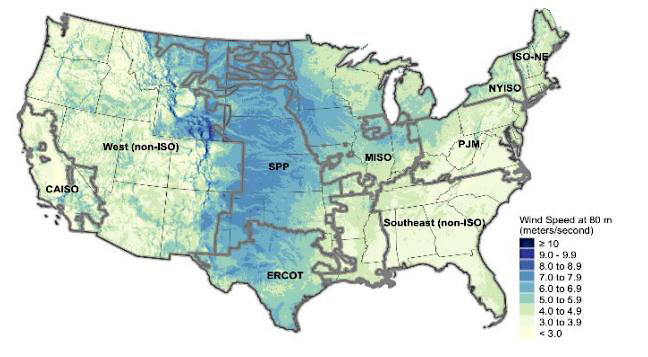 As the data in Figure 2 show, wind energy curtailment does not increase in lockstep with increases in wind energy adoption. With each passing year, wind adoption as a percentage of total resource mix has generally increased within all seven ISO/RTOs, while wind curtailment has fluctuated from year to year within each region and varies between them (Wiser et al. 2021). SPP and ERCOT currently have higher adoption levels of wind than MISO, but lower curtailment levels. The California Independent System Operator (CAISO) has higher wind adoption levels than New York's (NYISO) or New England's (ISO-NE), yet it has lower curtailment levels.
As the data in Figure 2 show, wind energy curtailment does not increase in lockstep with increases in wind energy adoption. With each passing year, wind adoption as a percentage of total resource mix has generally increased within all seven ISO/RTOs, while wind curtailment has fluctuated from year to year within each region and varies between them (Wiser et al. 2021). SPP and ERCOT currently have higher adoption levels of wind than MISO, but lower curtailment levels. The California Independent System Operator (CAISO) has higher wind adoption levels than New York's (NYISO) or New England's (ISO-NE), yet it has lower curtailment levels.
Wind is curtailed when there is an oversupply of energy causing congestion somewhere on the bulk power system. Some describe this as being an "oversupply of wind." However, describing wind curtailment as an "oversupply of wind" is misleading and problematic; it misstates the underlying issues and hinders an exploration and adoption of the best solutions, discussed below. It also gives the impression that there is too much wind energy. If anything, the opposite is true. We need more wind energy as part of the clean, affordable, and reliable electricity grid of the future.
 Analysis of Electricity Mix During Wind Curtailment Events
Analysis of Electricity Mix During Wind Curtailment Events
The Union of Concerned Scientists commissioned analysis from Synapse Energy Economics to investigate wind curtailment in SPP. SPP has the highest level of wind adoption as a percentage of total load and is consequently the ISO/RTO most likely to experience "wind oversupply" events. The analysis accessed downloadable data files of resource generation and corresponding curtailment data, allowing measurements of how much wind was available on the SPP grid at any given time. It examined the operation and resource mix of the SPP grid over the course of two years in five-minute increments, quantifying the portion of electricity demand met by wind energy versus other, dirtier sources of electricity with higher costs.
The results were clear: "a wind oversupply does not exist in SPP". Rather, in all hours where wind was curtailed, other higher-cost, more-polluting resources were still online (Figure 3). And, because of coal resources' higher marginal cost and emissions rate, electricity customers would be better off if SPP was able to curtail coal instead of wind. Customers could have saved more than $40 million and avoided nearly 1.2 million short tons of carbon emissions per year.2 If wind is available, burning coal is always more expensive, so why waste wind when there is plenty of coal to displace?
 Truth: Some Wind Curtailment Is Caused by Transmission Constraints
Truth: Some Wind Curtailment Is Caused by Transmission Constraints
Investments in the bulk transmission system have not kept pace with the adoption of wind energy. Inadequate transmission capacity combined with robust wind output causes localized congestion on the transmission system and limits how much wind can be delivered to load.
The ability of transmission to cost effectively alleviate the need for wind curtailment is well established. In Texas, ERCOT established Competitive Renewable Energy Zones that connected concentrated wind farm development with load centers. This led to a dramatic reduction in wind curtailment after 2011, when most CREZ projects were completed. In MISO, the Multi-Value Projects portfolio of transmission projects was approved to provide access to renewable energy for the states in the MISO territory that had recently enacted renewable energy portfolio standards. Thirteen transmission projects were completed, delivering between $1.50 and $2.60 in benefits for every dollar invested, mostly from reduced congestion. Both of these success stories involve building transmission in anticipation of new wind development. New transmission investments can also improve market efficiency by reducing congestion on the transmission system and thus enabling the access of lower-cost resources like wind across the system. Unfortunately, market efficiency projects are rarely approved, with contentious debates about who benefits and who pays, and which are further clouded by incumbent interests trying to protect their market share from lower-cost competition.
Ultimately, transmission investments are necessary to debottleneck transmission constraints. Such investments will deliver more wind energy to consumers while displacing more costly and dirtier resources. To blame wind curtailments caused by transmission constraints on a "wind oversupply" is wrong. Better to put the focus on solutions and call it a transmission undersupply.
Truth: Some Wind Curtailment Is Caused by Coal Operated Inflexibly
One of the primary responsibilities of ISO/RTOs is the economic dispatch of all available generation resources.3 This is most efficiently achieved when the owners of resources marketcommit, allowing the market operator's computers to turn the power plant on and off or up and down. However, many resources (including wind and coal) will often self-commit in the energy market, a practice that essentially prevents the grid operator from turning the power plant off. But not all self-commitment is created equal.
ISO/RTO rules require wind generation to be able to be reduced as low as zero (effectively turning it off), while coal is allowed to stay on at a minimum operating level with minimal scrutiny of how that minimum is set. When there are oversupply events on the grid, the grid operator cannot turn off these coal plants and are forced to curtail wind. This lack of coal flexibility also costs customers across all coal-heavy ISO/RTOs about $1 billion per year.
Self-commitment of coal plants has come under increasing scrutiny in MISO and SPP over the past few years, and as a consequence those markets have increased their reporting on the issue. Market commitment has increased over the past few years, but some power plants continue to operate inflexibly and exploit market rules like selfcommitment. The continued exploitation of self-commitment protocols—even if transmission constraints were to be overcome means that some wind curtailment would persist as long as other power plants are operated inflexibly.
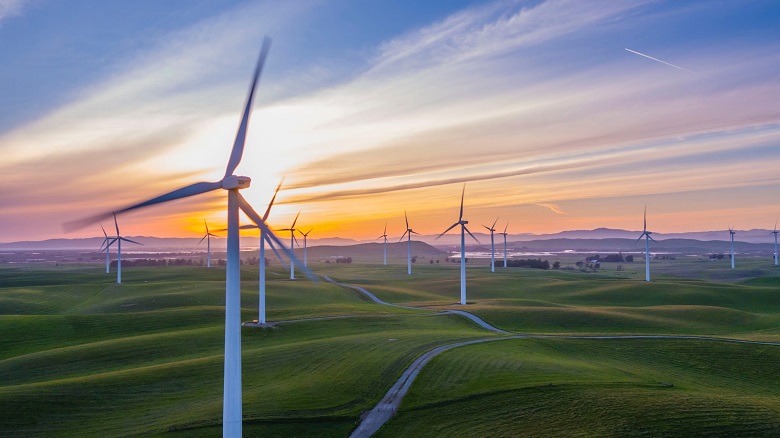 Truth: Some Wind Curtailment Is Caused by Lack of Battery Storage
Truth: Some Wind Curtailment Is Caused by Lack of Battery Storage
There is some storage capacity on the current electric grid, but only a very small amount of the annual electricity supply gets stored for later use. Luckily, this is rapidly changing. Large-scale energy storage increased threefold between 2016 and 2019 and is expected to increase another sixfold between 2020 and 2023. A large portion of the wind curtailment events were short-duration events in hours when the local wholesale market price was negative. Those types of events are well suited to charge a four-hour battery, to be discharged when prices have gone back up.
The ability of stand-alone storage projects to help avoid wind curtailments is highly dependent on other system constraints; the benefits of storage are location-sensitive. With the current underbuilt transmission system, in order to help avoid wind curtailment, storage would have to be co-located at the wind farm or upstream of transmission system constraints. If, however, transmission constraints were mitigated and resources like coal were operated more flexibly (with lower minimum operation levels), then storage could effectively help to avoid curtailment when located in more diverse locations across the transmission and/or distribution system.
Wind Curtailment: Probable Tomorrow, but Avoidable Today
Down the road, when the grid is nearly or fully decarbonized, there might be sufficient wind or solar on the grid to cause actual renewable energy oversupply, at which point curtailment might be a cost-effective choice. The need to build more transmission and storage today is not to say that grid planners should overbuild the system to deliver every single megawatt-hour of wind generation tomorrow. At some point in the future, some amount of wind curtailment might be cost-optimal (i.e., the incremental cost to add storage or transmission might far exceed the benefits of avoided curtailment).
For now, at current and near-term levels of wind deployment, significant amounts of wind curtailment can be avoided by building transmission to more effectively move renewable energy across the grid, by ending uneconomic self-commitment so that coal plants can be turned down to a greater degree and renewables can get from the grid to the load, and by building storage to soak up any remaining renewable energy that cannot be used or exported.
Misunderstandings about the causes of wind curtailment can prevent effective solutions. If grid operators were forced to curtail wind because wind energy alone was exceeding demand, that would be a good indicator of a system-wide oversupply of wind. But what wind curtailment today is showing us is that we have an underbuilt transmission system, excess coal plants that are operated inflexibly, and a lack of sufficient storage. Absent those constraints, more wind energy could be delivered to load.
Wind energy's abundance and low cost have driven its rise to prominence on the electricity grid. As a percentage of total electricity supply, wind energy has been concentrated, not surprisingly, in independent system operators (ISOs) and regional transmission organizations Union of Concerned Scientists(RTOs) where it is windiest (Figure 1). The Midcontinent Independent System Operator (MISO), the Electric Reliability Council of Texas (ERCOT), and SPP saw wind energy comprise more than 10 percent, 20 percent, and 30 percent of their electricity mix, respectively, in 2020 (see Figure 2).

Wind is curtailed when there is an oversupply of energy causing congestion somewhere on the bulk power system. Some describe this as being an "oversupply of wind." However, describing wind curtailment as an "oversupply of wind" is misleading and problematic; it misstates the underlying issues and hinders an exploration and adoption of the best solutions, discussed below. It also gives the impression that there is too much wind energy. If anything, the opposite is true. We need more wind energy as part of the clean, affordable, and reliable electricity grid of the future.

The Union of Concerned Scientists commissioned analysis from Synapse Energy Economics to investigate wind curtailment in SPP. SPP has the highest level of wind adoption as a percentage of total load and is consequently the ISO/RTO most likely to experience "wind oversupply" events. The analysis accessed downloadable data files of resource generation and corresponding curtailment data, allowing measurements of how much wind was available on the SPP grid at any given time. It examined the operation and resource mix of the SPP grid over the course of two years in five-minute increments, quantifying the portion of electricity demand met by wind energy versus other, dirtier sources of electricity with higher costs.
The results were clear: "a wind oversupply does not exist in SPP". Rather, in all hours where wind was curtailed, other higher-cost, more-polluting resources were still online (Figure 3). And, because of coal resources' higher marginal cost and emissions rate, electricity customers would be better off if SPP was able to curtail coal instead of wind. Customers could have saved more than $40 million and avoided nearly 1.2 million short tons of carbon emissions per year.2 If wind is available, burning coal is always more expensive, so why waste wind when there is plenty of coal to displace?

Investments in the bulk transmission system have not kept pace with the adoption of wind energy. Inadequate transmission capacity combined with robust wind output causes localized congestion on the transmission system and limits how much wind can be delivered to load.
The ability of transmission to cost effectively alleviate the need for wind curtailment is well established. In Texas, ERCOT established Competitive Renewable Energy Zones that connected concentrated wind farm development with load centers. This led to a dramatic reduction in wind curtailment after 2011, when most CREZ projects were completed. In MISO, the Multi-Value Projects portfolio of transmission projects was approved to provide access to renewable energy for the states in the MISO territory that had recently enacted renewable energy portfolio standards. Thirteen transmission projects were completed, delivering between $1.50 and $2.60 in benefits for every dollar invested, mostly from reduced congestion. Both of these success stories involve building transmission in anticipation of new wind development. New transmission investments can also improve market efficiency by reducing congestion on the transmission system and thus enabling the access of lower-cost resources like wind across the system. Unfortunately, market efficiency projects are rarely approved, with contentious debates about who benefits and who pays, and which are further clouded by incumbent interests trying to protect their market share from lower-cost competition.
Ultimately, transmission investments are necessary to debottleneck transmission constraints. Such investments will deliver more wind energy to consumers while displacing more costly and dirtier resources. To blame wind curtailments caused by transmission constraints on a "wind oversupply" is wrong. Better to put the focus on solutions and call it a transmission undersupply.
Truth: Some Wind Curtailment Is Caused by Coal Operated Inflexibly
One of the primary responsibilities of ISO/RTOs is the economic dispatch of all available generation resources.3 This is most efficiently achieved when the owners of resources marketcommit, allowing the market operator's computers to turn the power plant on and off or up and down. However, many resources (including wind and coal) will often self-commit in the energy market, a practice that essentially prevents the grid operator from turning the power plant off. But not all self-commitment is created equal.
ISO/RTO rules require wind generation to be able to be reduced as low as zero (effectively turning it off), while coal is allowed to stay on at a minimum operating level with minimal scrutiny of how that minimum is set. When there are oversupply events on the grid, the grid operator cannot turn off these coal plants and are forced to curtail wind. This lack of coal flexibility also costs customers across all coal-heavy ISO/RTOs about $1 billion per year.
Self-commitment of coal plants has come under increasing scrutiny in MISO and SPP over the past few years, and as a consequence those markets have increased their reporting on the issue. Market commitment has increased over the past few years, but some power plants continue to operate inflexibly and exploit market rules like selfcommitment. The continued exploitation of self-commitment protocols—even if transmission constraints were to be overcome means that some wind curtailment would persist as long as other power plants are operated inflexibly.

There is some storage capacity on the current electric grid, but only a very small amount of the annual electricity supply gets stored for later use. Luckily, this is rapidly changing. Large-scale energy storage increased threefold between 2016 and 2019 and is expected to increase another sixfold between 2020 and 2023. A large portion of the wind curtailment events were short-duration events in hours when the local wholesale market price was negative. Those types of events are well suited to charge a four-hour battery, to be discharged when prices have gone back up.
The ability of stand-alone storage projects to help avoid wind curtailments is highly dependent on other system constraints; the benefits of storage are location-sensitive. With the current underbuilt transmission system, in order to help avoid wind curtailment, storage would have to be co-located at the wind farm or upstream of transmission system constraints. If, however, transmission constraints were mitigated and resources like coal were operated more flexibly (with lower minimum operation levels), then storage could effectively help to avoid curtailment when located in more diverse locations across the transmission and/or distribution system.
Wind Curtailment: Probable Tomorrow, but Avoidable Today
Down the road, when the grid is nearly or fully decarbonized, there might be sufficient wind or solar on the grid to cause actual renewable energy oversupply, at which point curtailment might be a cost-effective choice. The need to build more transmission and storage today is not to say that grid planners should overbuild the system to deliver every single megawatt-hour of wind generation tomorrow. At some point in the future, some amount of wind curtailment might be cost-optimal (i.e., the incremental cost to add storage or transmission might far exceed the benefits of avoided curtailment).
For now, at current and near-term levels of wind deployment, significant amounts of wind curtailment can be avoided by building transmission to more effectively move renewable energy across the grid, by ending uneconomic self-commitment so that coal plants can be turned down to a greater degree and renewables can get from the grid to the load, and by building storage to soak up any remaining renewable energy that cannot be used or exported.
Post a Comment:
You may also like:

Featured Articles
What Are the Advantages of Wind Energy?
 Wind power is the fastest-growing source of electricity worldwide. The American Wind Energy Association estimates that more ...
Wind power is the fastest-growing source of electricity worldwide. The American Wind Energy Association estimates that more ...
 Wind power is the fastest-growing source of electricity worldwide. The American Wind Energy Association estimates that more ...
Wind power is the fastest-growing source of electricity worldwide. The American Wind Energy Association estimates that more ...What is the Wind Energy Conversion ...
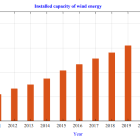 Due to technical and economic visibility, wind power has emerged as one of the most promising renewable energy sources ...
Due to technical and economic visibility, wind power has emerged as one of the most promising renewable energy sources ...
 Due to technical and economic visibility, wind power has emerged as one of the most promising renewable energy sources ...
Due to technical and economic visibility, wind power has emerged as one of the most promising renewable energy sources ...Technical Potential for Wind Energy
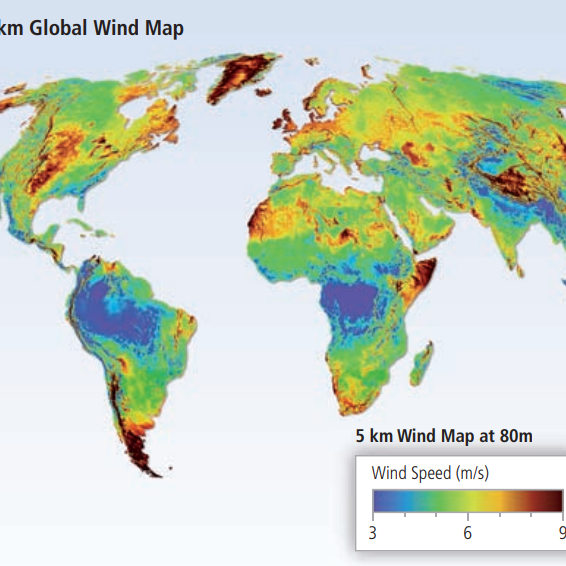 The theoretical potential for wind, as estimated by the global annual flux, has been estimated at 6,000 EJ/yr. The global ...
The theoretical potential for wind, as estimated by the global annual flux, has been estimated at 6,000 EJ/yr. The global ...
 The theoretical potential for wind, as estimated by the global annual flux, has been estimated at 6,000 EJ/yr. The global ...
The theoretical potential for wind, as estimated by the global annual flux, has been estimated at 6,000 EJ/yr. The global ...Wind Energy Background
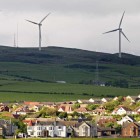 The kinetic energy in the wind is a promising source of renewable energy with significant potential in many parts of the world. ...
The kinetic energy in the wind is a promising source of renewable energy with significant potential in many parts of the world. ...
 The kinetic energy in the wind is a promising source of renewable energy with significant potential in many parts of the world. ...
The kinetic energy in the wind is a promising source of renewable energy with significant potential in many parts of the world. ...How Wind Energy is Collected and ...
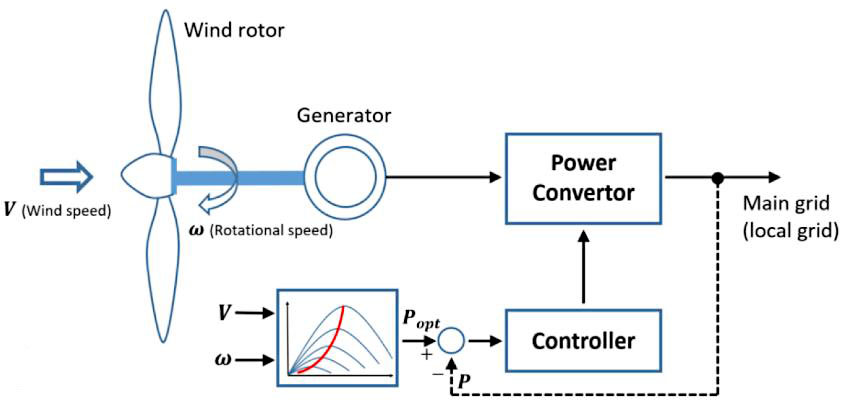 Wind energy is a form of solar energy. Earth’s atmosphere is unevenly heated by solar radiation and the air is in constant motion ...
Wind energy is a form of solar energy. Earth’s atmosphere is unevenly heated by solar radiation and the air is in constant motion ...
 Wind energy is a form of solar energy. Earth’s atmosphere is unevenly heated by solar radiation and the air is in constant motion ...
Wind energy is a form of solar energy. Earth’s atmosphere is unevenly heated by solar radiation and the air is in constant motion ...